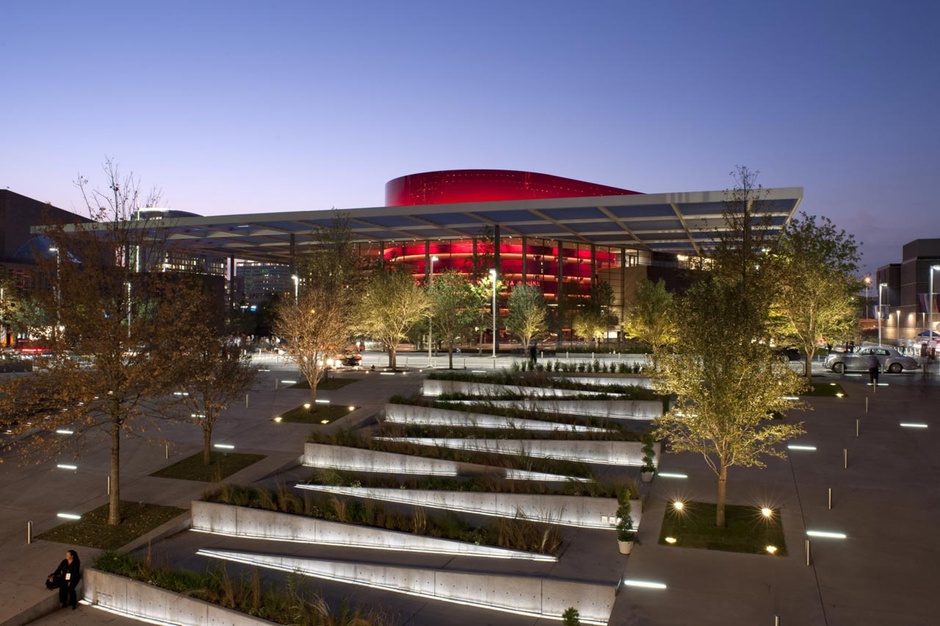New York has the nation’s tallest skyscraper. Chicago has some fancy buildings. But one city wins when it comes to sheer density of urban design.
For as long as there’ve been skyscrapers, Chicago and New York have been elbowing each other for dominance over the sky. Late in 2013, the Chicago Tribune‘s Blair Kamin did his best to downplay a controversial decision* by the Council on Tall Buildings and Urban Habitat that gave the upper hand to New York. One World Trade Center bested Willis Tower, the former Sears Tower, as the nation’s tallest skyscraper.
Size is just one dimension to the contest (and for most of the 20th century, New York led this measure). On subjective design criteria, it’s harder to judge who comes out on top. There is no council tasked with deciding between Chicago’s 330 North Wabash, Marina City, and Aqua Tower, on the one hand, and New York’s Woolworth Building, 432 Park Avenue, and New York by Gehry, on the other.
Consider a third metric. Looking at cities by density of design, Dallas has both New York and Chicago beat.
From our partners:
That’s right, the Big D. If you look past the nation’s tallest and most spectacular designs and focus on the sheer concentration of great design, you’ll find that there is no place that packs in better design than the city’s Arts District. While this standard doesn’t quite rise to the rigor of objectivity, it is juried. Dallas, it turns out, is host to the densest design district in the country.

Six different Pritzker Prize-winning architects have designed signature buildings in the Arts District, all within an area that’s smaller than a square mile. All of the designers have won other prestigious awards, including Japan’s Praemium Imperiale, the American Institute of Architects’ Gold Medal, and the Royal Institute of British Architects’ Gold Medal. Dallas’ superior six includes one architect who’s been knighted by France, one who’s been knighted by England, and one who’s been named a senator for life in Italy.
Dallas can’t be beat when it comes to design density. No other geographic area in the nation this small can brag on as much architecture by architects who have received the top honors in their fields.

Houston comes in at a close second. Steven Holl’s expansion for the Museum of Fine Arts, Houston, will not only add a signature building to a district that’s already chock-a-block with them, it will upgrade the urban fabric connecting these buildings across the neighborhood. While Holl isn’t a Pritzker Prize winner, his name always makes the unofficial shortlists, plus he’s earned plenty of hardware from other juries. Elsewhere in Houston’s Museum District are buildings by Rafael Moneo, Renzo Piano, and Robert Venturi—all Pritzker laureates.
Given that this patch of Houston also claims Yoshio Taniguchi’s Asia Society Texas Center, a new Menil Drawing Institute from up-and-comers Johnston Marklee, college buildings by Michael Graves all over nearby Rice University, and a vision for the MFAH steered by Mies van der Rohe, it would be easy to argue Houston’s claim to the densest design district in the nation. Between H-Town and Dallas, it’s a close call. But Mies died a decade before the first Pritzker Prize was ever awarded (to Philip Johnson, whose fingerprints are all over Houston). And Michael Graves has yet to be so honored for his buildings for Rice University (which are a light-rail stop away).


To be sure, with any arbitrary standard comes some caveats. Ranking design-heavy areas by the number of awards designers have racked up is a little like looking at the buildings’ resumes rather than the buildings themselves. And unfortunately, architecture is far from an equal-opportunity-employer. Critic Alexandra Lange outlined at length last month how the American Institute of Architects skips over women in its Gold Medal selections. In 2013, architect Denise Scott Brown went public with the complaint that her husband, Robert Venturi, received the Pritzker Prize alone in 1991 for work that the pair did jointly (as Venturi Scott Brown and Associates). People of color are poorly represented at all levels of the field, from school to starchitecture. So judging by prize counts is hardly an objective measure when the prizes themselves are so subjective.


Dallas isn’t an unimpeachable choice. REX’s Joshua Prince-Ramus actually took the lead on the Wyly Theatre, not OMA’s Rem Koolhaas, to nitpick a little. Johnson’s Thanks-Giving Square is a departure from the other choices. Dallas’ new Museum Tower is working very hard to melt the Nasher Sculpture Center. There’s not enough connective thread to call the Arts District a neighborhood—not yet.
Nevertheless, the city has worked hard to building something new. Four of the buildings—the Nasher Sculpture Center, Winspear Opera House, Wyly Theatre, and Perot Museum of Nature and Science—were built in Dallas since 2003. (The latter three came up within just the last five years or so.) And there’s much more to the Arts District than buildings designed by Pritzker winners (plus more ways to get there).
Book a boat tour with the Chicago Architecture Foundation to see the most dynamic range of design on view on any trip you can take in the U.S. A driving tour of Los Angeles architecture will yield some of the nation’s greatest buildings. Stroll down NYC’s mile-and-a-half High Line for the best new architecture walk anywhere.
But for sheer density of great design in a single destination? Head to Dallas.

This article originally appeared in CityLab.













